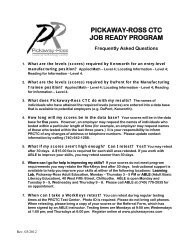Commons
Conceptual Physics - elearning-phys
Conceptual Physics - elearning-phys
- No tags were found...
You also want an ePaper? Increase the reach of your titles
YUMPU automatically turns print PDFs into web optimized ePapers that Google loves.
a / A figure skater pulls inher arms so that she can executea spin more rapidly.gen atom spins at the same rate for billions of years. A high-diverwho is rotating when he comes off the board does not need to makeany physical effort to continue rotating, and indeed would be unableto stop rotating before he hit the water.These observations have the hallmarks of a conservation law,but what numerical measure of rotational motion is conserved? Carengines and old-fashioned LP records have speeds of rotation measuredin rotations per minute (r.p.m.), but the number of rotationsper minute (or per second) is not a conserved quantity. For example,the twirling figure skater in figure a can pull her arms in to increaseher r.p.m.’s.The example of the figure skater suggests that this conservedquantity depends on distance from the axis of rotation. We’ll notatethis distance as r, since, for an object moving in a circle around anaxis of rotation, its distance from the axis equals the radius of thecircle.Once we realize that r is a variable that matters, it becomes clearthat the examples we’ve been considering were all examples thatwould be fairly complicated mathematically, because different partsof these objects’ masses have different values of r. For example,the figure skater’s front teeth are farther from the axis than herback teeth. That suggests that instead of objects with complicatedshapes, we should consider the simplest possible example, which isa single particle, of mass m, traveling in a circle of radius r at speedv. Experiments show that the conserved quantity in this situationis±mvr .We call this quantity angular momentum. The symbol ± indicatesthat angular momentum has a positive or negative sign to representthe direction of rotation; for example, in a given problem, we couldchoose to represent clockwise angular momenta as positive numbers,and counterclockwise ones as negative. In this equation, the onlyvelocity that matters is velocity that is perpendicular to the radiusline; motion parallel to the radius line, i.e., directly in our out, isneither clockwise nor counterclockwise.A figure skater pulls her arms in example 1When the skater in figure a pulls her arms in, she is decreasingr for all the atoms in her arms. It would violate conservationof angular momentum if she then continued rotating at thesame speed, i.e., taking the same amount of time for each revolution,because her arms would be closer to the axis of rotationand therefore have a smaller r (as well as a smaller v becausethey would be completing a smaller circle in the same time). Thisis impossible because it would violate conservation of angularmomentum. If her total angular momentum is to remain constant,the decrease in angular momentum for her arms must be com-64 Chapter 3 Conservation of Angular Momentum



